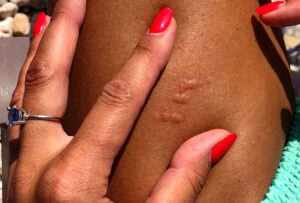Insect bites and stings on black skin may be harder to see due to the skin’s pigmentation, but they can still cause noticeable symptoms like swelling, itching, and pain. It’s important to monitor for signs of infection and seek medical advice if symptoms worsen or don’t improve.

Identifying Bites and Stings:
- Swelling and redness: While redness might be less obvious, swelling and a raised area around the bite or sting are still indicators.
- · Itching and pain: These are common symptoms that can be experienced with bites and stings.
- · Multiple bites: Bed bug bites, for example, often appear in clusters or lines.
- · Individual reactions: Reactions can vary, so it’s important to be aware of any changes in your skin after a bite or sting.
When to seek medical advice:
- Signs of infection: If the bite area becomes increasingly painful, swollen, warm, or develops pus, it may be infected.
- · Severe allergic reactions: Difficulty breathing, throat swelling, dizziness, or chest pain require immediate medical attention.
- · Persistent or worsening symptoms: If symptoms don’t improve or get worse after a few days, consult a doctor.
Treatment:
Clean the area with soap and water, apply a cold compress, and use over-the-counter pain relievers or antihistamines to reduce itching and pain.
Seek medical advice for appropriate treatment, which may include prescription medications or other therapies.
- · Preventing bites and stings:
Use insect repellent, cover exposed skin, and avoid strong perfumes, especially when outdoors.
